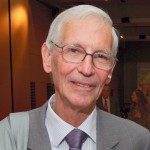During his PhD thesis with François Gros, Moshe Yaniv studied the genetic control of protein synthesis in E. coli. He isolated temperature sensitive mutants for growth and showed that they occur in several aminoacyl-tRNA synthetases. The second part of his thesis involved the purification of several tRNA and the determination of their sequence in the laboratory of Fred Sanger in Cambridge. In collaboration with A. Favre he showed that the 4-thioU residue of the tRNA could be specifically cross-linked to a non- adjacent C residue. With this information in hand together with J. Ninio they proposed a tri-dimensional model of tRNA that was not far from the final structure established later by X ray crystallography. During his postdoctoral stay in Paul Berg’s laboratory in Stanford he produced the first evidence that the anticodon of tRNA is required for its specific recognition by the cognate aminoacyl-tRNA synthetase.
Following his return to France he started a group studying the structure of Polyoma and SV40 mini-chromosomes. They discovered the nucleosome free region in these chromosomes and showed that such sequences are linked to enhancer function. Together with D. Blangy his group analyzed the sequence of Polyoma mutants that overcame the growth restriction of the virus in pluripotent embryonic cells and showed that they involve sequence rearrangements in the enhancer. This was the first demonstration that small sequence changes in enhancers can change the cell type specificity of gene expression. Following the replication of the viral mini-chromosomes they produced the first evidence showing that both parental histones and the newly synthesized histones associate with newly replicated DNA setting up the principles for transmission of epigenetic information.
In collaboration with G. Orth, Yaniv and colleagues cloned, sequenced and functionally characterized the first human papillomavirus genome. These were crucial insights that led to the later identification, by others, of genital papillomaviruses associated with cervical cancer. They discovered that the viral E2 protein can act both as a transcription activator and repressor depending on the position of binding sites on the viral DNA.
Developing methods to detect and characterize eukaryotic transcription factors interacting with viral or cellular transcription control elements, they adapted the gel shift assays of DNA- proteins complexes that were previously used in bacteria and drosophila to mouse or human cell extracts. With this approach his group was among the first to isolate and analyze the AP1 transcription factor (an heterodimer between Jun and Fos proteins), and to dissect its role in both transcription and replication of viral DNA. Together with R. Bravo they produced the first evidence that c-Jun is mediating the response to growth factors.
Moving on from viruses to study the elements in the genome that direct cell type specific gene expression and to investigate their potential role in development, Yaniv’s group collaborated with the laboratory of M. Weiss to map the sequence elements that control liver specific gene expression . This was followed by the purification and cloning of two key transcription factors, Hepatic Nuclear Factor 1a & b (HNF1a, b). Two highly divergent homeobox containg proteins that constitute a distinct mini family among homeobox genes. They produced HNF1a, b deficient mice as well as conditional inactivation that unravelled the key roles of these homeoproteins in directing liver, kidney and pancreas organogenesis and in diseases including phenylketonuria, familial type II diabetes and polycystic kidney disease in humans.
Coming back to chromatin, his group cloned the Brm helicase gene from humans, a major component of the human SWI/SNF or BAF chromatin remodelling complex and showed that it is important for the transcriptional activation of hormone responsive genes among others. Their studies also revealed a key role for the Brm helicase in growth control and suggested that the SWI/SNF complex may be considered as a candidate tumour suppressor complex. This was directly confirmed by the finding of O. Delattre and his group at the Curie Institute, who demonstrated that bi-allelic mutations or deletions of the SNF5/INI1 gene, another subunit of the complex that they cloned in collaboration with C. Sardet, is found in the quasi totality of infants with rhabdoid brain or kidney tumours. Identical tumours appeared in SNF5+/- mice that they generated. These mice served to unravel the cellular defects that occur in these tumours. Since then, exome sequencing revealed that mutations in the different subunits of the SWI/SNF complex occur in close to 40% of human tumours.
These studies were made possible by the contributions of many students, postdoctoral fellows and permanent members of the unit whose names are mentioned in the publication list.
